SECTION 4-B 1957 BUICK SYNCHROMESH TRANSMISSION AND UNIVERSAL JOINT
NOTE: 1957 Buick Synchromesh transmissions are standard and Dynaflow transmissions are optional on Series 40. Dynaflow is standard and Synchromesh is not available on Series 50-60-70.
4-7 1957 BUICK SYNCHROMESH TRANSMISSION AND UNIVERSAL JOINT SPECIFICATIONS
Tightening Specifications

1957 Buick Synchromesh Transmission Tightening Specifications
1957 Buick Synchromesh Transmission Specifications
NOTE: Where dimensions and limits for fit of parts are given in these specifications they apply to new parts only. Where limits are given, “T” means tight and “L” means loose.
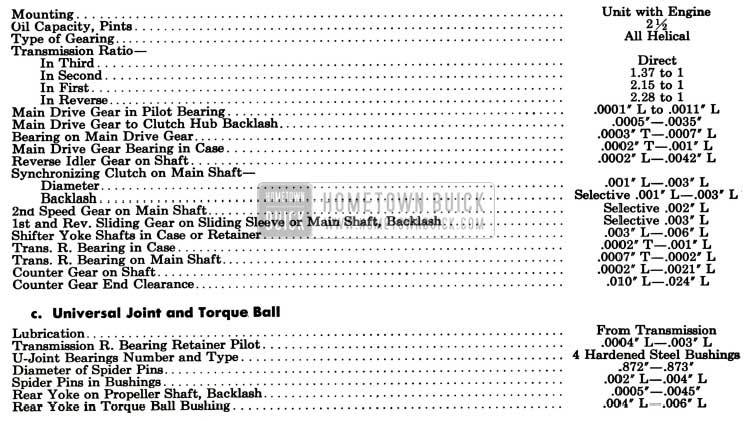
1957 Buick Synchromesh Transmission Specification
1957 Buick Synchromesh Universal Joint and Torque Ball (see above)
1957 Buick Synchromesh Speedometer Gears

1957 Buick Speedometer Gears Specifications
4-8 1957 BUICK SYNCHROMESH TRANSMISSION DESCRIPTION
The 1957 Buick Synchromesh transmission is solidly bolted to the rear face of flywheel upper housing, with a heavy paper gasket between, to form a unit assembly with the engine. The 1957 Buick Synchromesh transmission main drive gear extends through the clutch driven plate into a bronze bushing seated in the rear end of engine crankshaft. The outer race of main drive gear bearing projects from transmission case to seat in a counterbore in flywheel housing, thus serving as a pilot to center the 1957 Buick Synchromesh transmission with engine crankshaft.
1957 Buick Synchromesh Transmission Gears and Shafts
The 1957 Buick Synchromesh transmission main drive gear is supported by a ball bearing seated in front wall of 1957 Buick Synchromesh transmission case. The ball bearing, which is shielded on rearward side, is pressed against a shoulder on main drive gear and held in place by an oil slinger, washer, and retainer (snap ring). The outer race of bearing is grooved for a snap ring which fits between transmission case and flywheel housing to hold bearing and main drive gear in place. See figure 4-8.
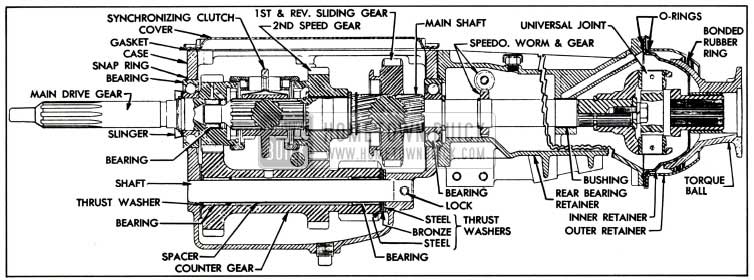
1957 Buick Synchromesh Transmission
The front end of 1957 Buick Synchromesh transmission main shaft is piloted in the bored rear end of main drive gear by a bearing consisting of 14 small rollers which are retained in drive gear by a washer and snap ring. The main shaft is also supported by the transmission rear bearing which seats in the rear wall of transmission case. The outer race of rear bearing is grooved for a snap ring which fits between 1957 Buick Synchromesh transmission case and the rear bearing retainer. The inner race of bearing is retained between a shoulder on main shaft and a snap ring seated in a groove in shaft. A bushing in rear bearing retainer supports the main shaft just forward of the universal joint.
The 1957 Buick Synchromesh transmission counter gear is supported by two roller bearings on a shaft which is held stationary in 1957 Buick Synchromesh transmission case by a grooved pin lock driven into holes in case and rear end of shaft. A tubular spacer and two thrust washers are located around the shaft between the roller bearings and a retaining washer is located at outer end of front bearing to hold rollers in position. End thrust is taken by a bronze thrust washer at each end of counter gear. Rear bronze washer is sandwiched between two steel thrust washers. Front steel washer also retains rollers and rear steel washer is pinned to case. A hole in hub of gear permits lubricant to reach bearings and thrust washers. See figure 4-8.
The reverse idler gear is provided with two bronze bushings and is supported on a shaft which is held stationary by a grooved pin lock driven into holes in 1957 Buick Synchromesh transmission case and front end of shaft. End thrust is taken by a bronze thrust washer at each end of idler gear. A hole in hub of gear permits lubricant to reach bushings and thrust washers.
The second speed gear is provided with a bronze bushing and is mounted on the main shaft in position to mesh with the counter gear. It is held in position between a thrust washer on main shaft and a thrust washer retained by a snap ring. The gear is free to rotate on the main shaft except when engaged by the gear synchronizing clutch during second speed operation.
The first and reverse sliding gear is splined to the main shaft, to rear of second speed gear, so that it can be moved forward to engage the counter gear for first speed or rearward to engage reverse idler for reverse. Its forward movement is limited by a snap ring retainer installed in a groove in main shaft. See figure 4-8.
1957 Buick Synchromesh Gear Shift and Synchronization
The 1957 Buick Synchromesh gear synchronizing clutch and the first and reverse sliding gear are actuated by the shift mechanism. The gear shift mechanism is described in paragraph 4-9.
The 1957 Buick Synchromesh gear synchronizing clutch is splined to the main shaft to transmit drive when clutch is engaged with either the main drive gear (third speed) or the second speed gear. The clutch assembly includes synchronizing drums and detent springs which act to synchronize the speed of the clutch with the gear it engages during a shift into second or third speed. The drums are joined together by three spacer pins which are notched to engage three detent springs which support the synchronizing parts on the clutch. See figure 4-9. As the clutch moves toward the gear, the detent springs press the drum into contact with the gear, after which the detent springs compress and disengage notches in the spacer pins to permit the clutch to engage the gear quietly and easily.
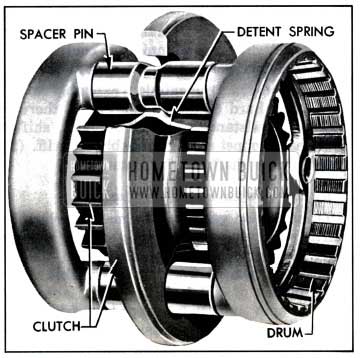
1957 Buick Gear Synchronizer Clutch
1957 Buick Synchromesh Speedometer Gears
The speedometer driving worm gear is pressed on the 1957 Buick Synchromesh transmission main shaft where it is located by a stop ring. See figure 4-8. An 8 tooth worm is used on all synchromesh cars; all Dynaflow cars use a 9 tooth worm. In changing axle ratios it is only necessary to change the driven gear.
The speedometer driven gear is furnished only as an assembly consisting of sleeve, shaft, retaining washer and gear. The driven gear sleeve is threaded into the 1957 Buick Synchromesh transmission rear bearing retainer and the speedometer cable is attached to the sleeve by a threaded sleeve on cable casing. The speedometer gears and driven gear shaft are lubricated from the 1957 Buick Synchromesh transmission.
1957 Buick Synchromesh Universal Joint and Torque Ball
The 1957 Buick Synchromesh universal joint is splined to the rear end of 1957 Buick Synchromesh transmission main shaft and retained by a heavy steel washer and bolt. It is entirely enclosed by the transmission rear bearing retainer and by the torque ball and retainers which are attached to rear end of the bearing retainer.
The universal joint yokes are provided with hardened and ground steel bushings, held by retainer rings, which provide bearings for the hardened and ground pins of the universal joint cross. The rear yoke is splined internally to engage the propeller shaft, and is ground externally to provide a bearing in a bronze bushing in the torque ball. See figure 4-13.
The 1957 Buick Synchromesh torque ball is supported between an inner and outer retainer which are centrally located and bolted to the 1957 Buick Synchromesh transmission rear bearing retainer. The torque ball has a bonded rubber compression ring which acts as a rubber cushion and seal between the ball and the outer retainer.
The universal joint, torque ball, and speedometer drive gears are automatically lubricated from the 1957 Buick Synchromesh transmission. A breather or air vent is installed in upper side of the rear bearing retainer to prevent a build up of pressure, due to heat, that would force transmission lubricant out past gaskets and oil seals. See figure 4-8.
4-9 1957 BUICK SYNCHROMESH TRANSMISSION SHIFT CONTROL MECHANISM
The first and reverse sliding gear is moved forward or rearward from the neutral position by a shifter yoke mounted on a shaft supported in left side of 1957 Buick Synchromesh transmission case. The gear synchronizing clutch is actuated by a yoke and shaft on right side of case. Each shifter yoke shaft is notched for engagement by one of two shifter levers mounted on a selector shaft which is supported in 1957 Buick Synchromesh transmission case at a right angle to yoke shaft. The levers are located on selector shaft so that only one lever at a time can engage its yoke shaft. See figure 4-10.
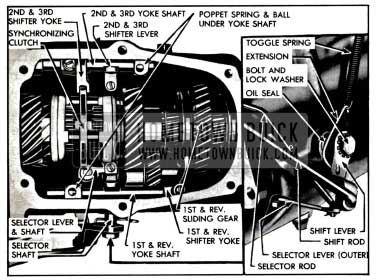
1957 Buick Shift Mechanism In Transmission
Engagement of a shifter lever with its yoke shaft, to select a gear shift, is obtained by moving selector shaft to right or left as required. This transverse movement of selector shaft is made by a selector lever and shaft which engages a notch in first and reverse shifter yoke. The selector lever shaft extends through 1957 Buick Synchromesh transmission case and has a lever on its outer end which is actuated by a selector rod connected to the selector control mechanism in steering column.
Forward or rearward movement of the selected shifter yoke shaft, to complete the gear shift, is obtained by rotating the selector shaft. This movement is made by a shift lever mounted on outer left end of shaft and actuated by a shift rod connected to the gear shift control mechanism in steering column. A toggle spring and extension attached to shift lever aids in moving the sliding parts. See figure 4-10. A spring loaded poppet ball, housed in a recess in 1957 Buick Synchromesh transmission case under each yoke shaft, engages one of three recesses in shaft to hold the shaft in desired position.
An interlock arrangement permits movement of one shifter yoke and shaft only when the opposite yoke shaft is locked in neutral position. The selector shaft pushes an interlock pin up into a notch in the first and reverse shifter yoke shaft to lock it when selector shaft moves to the right. When the selector shaft moves to the left, the interlock pin drops into a groove in selector shaft, thereby unlocking the yoke shaft. A grooved collar mounted on right end of selector shaft and a notch in the second and third shifter yoke shaft provide the locking device for that yoke shaft. See figure 4-11.
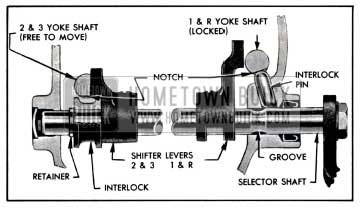
1957 Buick Transmission Interlock
4-10 1957 BUICK SYNCHROMESH TRANSMISSION TROUBLE DIAGNOSIS
Hard Shifting and Block-out
Hard shifting may be caused either by conditions in shift control mechanism in steering column or by conditions in 1957 Buick Synchromesh transmission assembly. Disconnect shift rod trunnion at control shaft lever to determine which unit is at fault.
Conditions in 1957 Buick Synchromesh transmission assembly which may cause hard shifting are: (1) If there is excessive resistance at start of shift, shifter yoke shaft poppet spring probably too stiff. (2) Shifter yoke shaft may be bent.
Low and Reverse Gear Clash
1957 Buick Synchromesh transmission gears can be made to clash by shifting into low or reverse gear too quickly after clutch pedal is depressed, even though clutch is in perfect working order. This is because inertia of clutch driven plate causes the plate to spin until it is stopped by friction of transmission and transmission lubricant. With warm transmission lubricant and low friction transmission bearings, a reasonable amount of spin is to be expected. The spin does not occur when shifting quickly into second or high gear because the synchronizing unit stops the driven plate.
To eliminate gear clash, sufficient time MUST be allowed before shifting into low after pedal is depressed or else starts must be made in second gear. There is no objection to making starts in second gear on level ground since the clutch slippage under ordinary driving conditions is not sufficient to produce enough heat to damage driven plate facings.
If gear clash continues after allowing proper time for clutch driven plate to stop, check clutch pedal lash and adjust to specified limits. See paragraph 4-4. Make sure that idle speed of engine when hot is 485 RPM. A faster idle aggravates driven plate spinning.
Conditions within the 1957 Buick Synchromesh transmission which may cause gear clash are: (1) Faulty synchronizing drums or cone surfaces; (2) Excessive main shaft end play; (3) Weak or broken detent springs in gear synchronizing clutch; (4) Gear clash also may be caused by a dragging clutch plate.
Noise in Neutral
With car standing, engine running, and 1957 Buick Synchromesh transmission in neutral, the transmission parts in operation are: main drive gear and bearing, counter gear and bearings, reverse idler gear, second speed gear. Disengaging clutch will stop movement of all these parts. By disengaging and engaging clutch it can be determined whether noise originates in these transmission parts and whether the noise is normal. Noise in neutral in the form of a constant regular click is usually caused by a nicked gear or bearing.
Gear Noise
Some gear noise is to be expected in all except third speed. Comparison with another car is the only means of determining whether or not gear noise is excessive. Before removing 1957 Buick Synchromesh transmission for correction of gear noise determine by test which gears are noisy under load, so that these can be thoroughly inspected when removed.
Gear Rattle During Acceleration
Improperly calibrated clutch driven plate, faulty crankshaft balancer, or scored rear axle gears may cause rattle in 1957 Buick Synchromesh transmission in third speed, on acceleration. Rattles occurring on wide open throttle between 40 and 60 MPH are usually caused by improper clutch driven plate dampening; a new driven plate should be installed if rattles are objectionable.
Noise When Shifting out of First or Reverse
Shifting out of first or reverse very slowly will usually result in some noise just as the gears disengage. This is normal because of the gear pointing necessary for easy engagement.
Abnormal noise during normally fast shift may be caused by improper clutch release. Check clutch pedal lash and adjust. See paragraph 4-4.
Abnormal noise during normally fast shift, when clutch release is satisfactory, may be caused by damage to pointing on engaging side of teeth on counter gear, reverse idler gear or first and reverse sliding gear. Noise when disengaging both first and reverse, indicates that fault is with sliding gear only. Noise when disengaging reverse only indicates reverse idler gear at fault. Noise when disengaging first speed only indicates counter gear at fault. Tests must be made by disengaging gears while car is still in motion.
Gear Jump-out
In any case of gear jump-out, first check the adjustment of gear shift control mechanism as described in paragraph 4-11. Make certain that poppet balls have full engagement in notches in shifter yoke shaft in all speed positions and neutral. Also make certain that toggle spring extension is not distorted so that it contacts the selector shaft. If these items do not correct gear jump-out, remove 1957 Buick Synchromesh transmission for examination of parts.
Gear jumping out of third speed may be caused by misalignment between the flywheel housing and crankshaft. See paragraph 4-14 for alignment correction procedure.
Gear jump-out in any transmission speed position may be caused by loose fit of bearings or bushings involved, weak poppet springs, loose fit of synchronizing clutch on main shaft, loose fit of sliding gear on main shaft, worn teeth on mating gears. All items should be carefully inspected.
Jumping out of second speed may be caused by gear synchronizing clutch being installed with wrong end toward second speed gear. See figure 4-24.
1957 Buick Synchromesh Transmission Lubricant Loss at Torque Ball
1957 Buick Synchromesh Transmission lubricant may be lost at torque ball as a result of:
- Scored universal joint or bushing.
- Clearance of more than .006″ between universal joint and bushing in torque ball.
- Worn or damaged propeller shaft oil seal.
- Excessive run-out of front end of propeller shaft.
- Worn or damaged rubber contact ring on torque ball face.
Scored or Broken Gear Teeth
Gear teeth will be seriously damaged and possibly broken, by failure of car operator to fully engage gears on every shift before engaging clutch and applying engine power.
Considerable damage to gears and bearings will result from running at abnormal speeds in reverse, first and second speed gears. This practice is also detrimental to the engine.
4-11 ADJUSTMENT OF 1957 BUICK SYNCHROMESH TRANSMISSION SHIFT CONTROLS
All adjustments are made with the 1957 Buick Synchromesh transmission in neutral and in position for shifting into second or third gear.
- With adapter assembly forced against flexible coupling flange, raise or lower jacket clamp until selector control lever pivot bushing clears control shaft lever by %6″. Then tighten clamp securely. See figure 4-12.
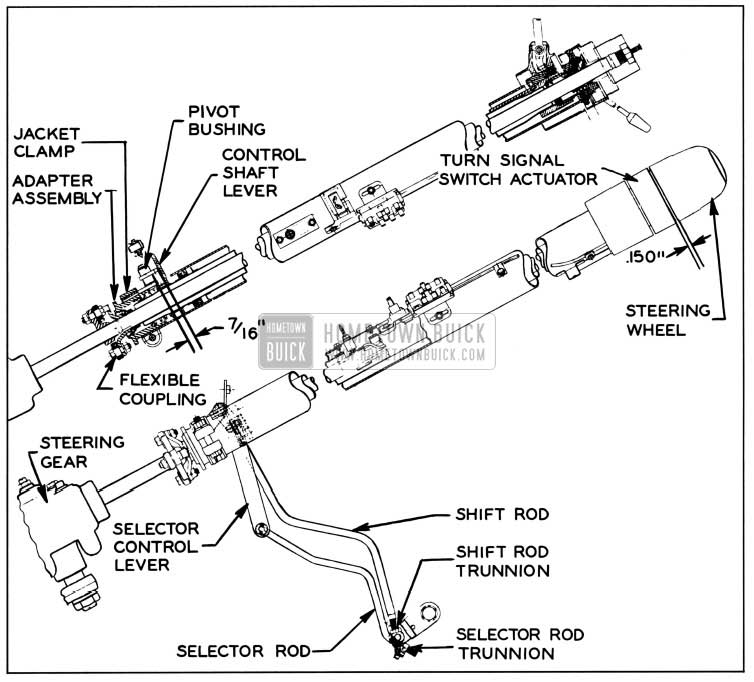
1957 Buick Synchromesh Transmission Shift Controls
4-12 REMOVAL AND INSTALLATION OF 1957 BUICK TORQUE BALL (S-M OR DYN.)
The torque ball has a bonded rubber contact ring on the outer ball face which is compressed between the inner and outer retainers. This rubber ring forms an oil tight seal. No shim adjustment is required on a bonded rubber torque ball.
- Disconnect rear axle assembly and move it back out of the way (par. 6-4, a). CAUTION: Be sure torque tube guide pins are installed before moving axle assembly back to avoid damaging propeller shaft seal.
- Remove retainer bolts, torque ball, retainers, and O-rings from 1957 Buick Synchromesh transmission rear bearing retainer. See figure 4-13.
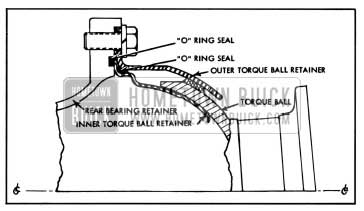
1957 Buick Torque Ball Assembly
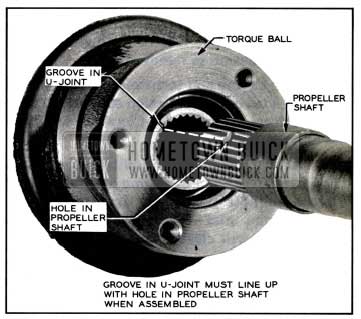
1957 Buick Aligning Propeller Shaft with Front Universal Joint
Install two torque tube guide pins. Move torque ball to align with torque tube flange and move axle assembly into place with hole in propeller shaft splines straight down. Rotate a rear wheel if necessary to keep hole in propeller shaft lined up with groove in universal joint. CAUTION: If these two markings are not aligned, the front and rear universal joints will be out of alignment, resulting in a severe vibration.
4-13 REMOVAL AND INSTALLATION OF 1957 BUICK SYNCHROMESH TRANSMISSION
Removal of 1957 Buick Synchromesh Transmission
- Disconnect rear axle assembly and move it back out of the way (par. 6-4). CAUTION: Be sure torque tube guide pins are installed before moving axle assembly back.
- Drain transmission lubricant. Fill with kerosene and run 1957 Buick Synchromesh transmission in neutral about 15 seconds. Drain cleaner.
- Remove clutch linkage shield. Install a 1/4″ x 2 1/2″ bolt and nut finger tight in gauging holes of clutch equalizer and bracket. CAUTION: Unless equalizer is thus locked in position, over-center spring may cause injury.
- Remove clevis pin connecting release rod end to clutch yoke and disengage return spring. See figure 4-4.
- Remove two bolts holding equalizer bracket to 1957 Buick Synchromesh transmission.
- Disconnect speedometer cable. Disconnect shift rod and selector rod from their levers.
- Disconnect rubber thrust pad from transmission thrust bracket, leaving thrust pad bolted to transmission support. Disconnect rubber mounting pad from transmission support, leaving mounting pad bolted to 1957 Buick Synchromesh transmission.
- Place a suitable jack under rear of engine pan so that engine will be safely supported while 1957 Buick Synchromesh transmission is removed.
- Raise engine and transmission just enough to relieve load on transmission support. Remove support from frame, noting location and number of shims present.
- Loosen exhaust pipe joints so that transmission and rear end of engine may be lowered. Place a suitable jack under transmission and lower engine and transmission jacks until transmission will clear frame X-member.
- Remove two upper transmission to flywheel housing bolts and install Guide Pins J-851-A to support 1957 Buick Synchromesh transmission. See figure 4-15. Remove lower bolts, then move transmission straight out until clear of flywheel housing and lower to floor.
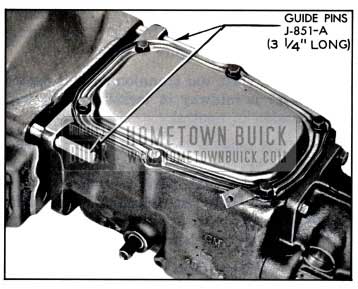
1957 Buick Transmission Guide Pins
CAUTION. If weight of 1957 Buick Synchromesh transmission is allowed to rest on main drive gear in clutch driven plate hub, driven plate may be damaged. NOTE: Guide Pins J-851-A are identical with the old Guide Pins J-851 except for being 5/8″ shorter.
Installation of 1957 Buick Synchromesh Transmission
- Lightly coat splines on end of main drive gear with Lubriplate for a distance of not more than 1″. Do not apply an excess that will push off at driven plate hub and get on clutch plate facings.
- Make certain that front face of 1957 Buick Synchromesh transmission case and face of flywheel housing are absolutely clean. Install Guide Pins J-851-A in upper bolt holes in housing (figure 4-15). Install a new 1957 Buick Synchromesh transmission gasket. Make certain that spring washer is in place behind clutch release bearing support in housing.
- Lift 1957 Buick Synchromesh transmission into place and fully support it until main drive gear bearing enters flywheel housing. Clutch driven plate may be damaged if weight of 1957 Buick Synchromesh transmission is allowed to rest on main drive gear in driven plate hub.
- Install lower transmission attaching bolts and remove Guide Pins. Then install upper bolts and tighten all bolts evenly and securely. CAUTION: If a gap exists between 1957 Buick Synchromesh transmission case and flywheel housing, do not tighten bolts or case may be broken. Remove 1957 Buick Synchromesh transmission and check position of main drive gear bearing snap ring and release bearing support spring washer. Either may have slipped out of place during installation.
- Install 1957 Buick Synchromesh transmission support with shims in original location. Shims should be of proper number and thickness to just fill space between support and frame.
- Lower transmission to rest on support. Attach thrust pad to transmission thrust bracket with bolt plate and three self-locking nuts and tighten securely. Then attach mounting pad to 1957 Buick Synchromesh transmission support with bolt plate and two self-locking nuts. Tighten securely.
- Connect speedometer cable, shift rod and selector rod.
- Make sure clutch cable is over pulley and ball end is engaged with equalizer quadrant. Then install equalizer assembly on transmission with two bolts.
- Check clutch pedal lash adjustment as described in paragraph 4-4 (a). Then install clevis pin connecting clutch release rod end to clutch yoke. Hook return spring over pin, then install flat washer and cotter pin.
- Adjust clutch cable length until gauging bolt just fits freely in gauging holes of equalizer (par. 4-4, a). After adjusting, be sure gauging bolt or pin is removed.
- Install clutch linkage shield and install large equalizer pivot bolt nut.
- Fill torque ball with 1957 Buick Synchromesh transmission lubricant through universal joint splines (about 1/2 pint). Then fill transmission to filler plug level (about 2 pints). See paragraph 1-1 for specified lubricant.
- Align universal joint marking with propeller shaft marking as described in paragraph 4-12.
- Install rear axle assembly (par. 6-4).
- Road test car, checking for proper selection and shifting of 1957 Buick Synchromesh transmission, correct synchronization and quiet operation of gears, bearings and shifter yokes. In neutral, the lower control shaft lever should be midway in the steering column jacket opening. If lever strikes edge of opening when 1957 Buick Synchromesh transmission is shifted into any gear, shift controls must be adjusted as described in paragraph 4-11.
4-14 ALIGNMENT OF 1957 BUICK SYNCHROMESH FLYWHEEL UPPER HOUSING
The flywheel upper housing which joins the 1957 Buick Synchromesh transmission to the engine crankcase is attached to the crankcase by bolts, with two straight dowels to maintain alignment.
Misalignment between the pilot hole which receives the main drive gear bearing in rear wall of housing and the pilot bushing in rear end of crankshaft may cause the 1957 Buick Synchromesh transmission to be noisy or to slip out of high gear. To insure correct alignment in production, the pilot hole is bored in the housing after it is assembled to the cylinder crankcase. The flywheel housing furnished for service is completely machined, but it must be checked for alignment after installation.
If an existing housing is suspected of being out of alignment it may be checked after removal of the 1957 Buick Synchromesh transmission and clutch assemblies. If a new housing or cylinder crankcase is being installed, alignment should be checked before the flywheel, clutch and 1957 Buick Synchromesh transmission are installed. When checking alignment the engine must be in an upright position, dowel pins must be installed, and all housing bolts must be tight.
Checking Alignment of 1957 Buick Synchromesh Flywheel Upper Housing
- Remove 1957 Buick Synchromesh transmission (par. 4-13) and clutch (par. 4-5), leaving flywheel in place.
- Attach Indicator Support J 4710-1 to flywheel with two flywheel bolts. Mount Dial Indicator KMO 30-B and Hole Attachment KMO 30-F on pilot with Sleeve KMO 30-K. Adjust ball end of hole attachment to bear against side of pilot hole in flywheel housing. See figure 4-16.
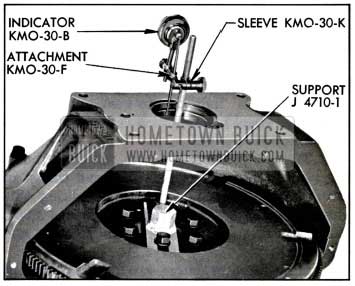
1957 Buick Checking Alignment of Housing at Pilot Hole
Correction of 1957 Buick Synchromesh Flywheel Upper Housing Misalignment
- Remove 1957 Buick Synchromesh flywheel upper housing and dowel pins from crankcase.
- Drill out bolt holes in flywheel housing with a 1/2″ drill.
- Install flywheel housing without dowel pins, and leave bolts just loose enough to permit shifting of housing by tapping with lead hammer.
- Install dial indicator as shown in figure 4-16, and check run-out at pilot hole in housing.
- Shift housing by tapping with lead hammer as required to bring run-out at pilot hole within .002″ indicator reading. Tighten housing bolts and re-check run-out.
- Using Special Reamer J 2548-3 and Ratchet Wrench J 808-6, ream the dowel holes and install two oversize dowel pins J 808-5.
- Mount dial indicator to bear against rear face of flywheel housing at a radius of 2 1/2″, as shown in figure 4-17.
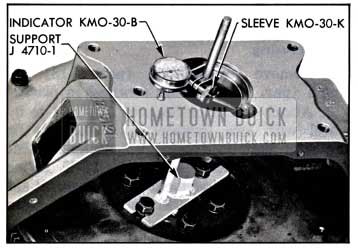
1957 Buick Checking Run-Out of Rear Face of Housing
4-15 DISASSEMBLY, INSPECTION, ASSEMBLY OF 1957 BUICK SYNCHROMESH TRANSMISSION
Disassembly of 1957 Buick Synchromesh Rear Bearing Retainer
- Thoroughly clean all dirt from exterior of 1957 Buick Synchromesh transmission to avoid getting any dirt into rear bearing retainer when opened.
- Remove speedometer driven gear assembly.
- Remove torque ball assembly (par. 4-12).
- Remove retaining bolt and washer, then pull universal joint from main shaft using Puller J-682-A. To use puller, install the pressure plug in 1957 Buick Synchromesh transmission main shaft, insert puller in universal joint rear yoke, install the “C” washer in groove in puller body on front side of yoke, and then turn screw handle clockwise. See figure 4-18.
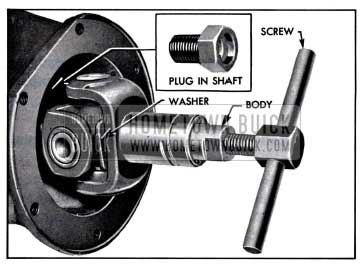
1957 Buick Removing Univenal Joint with Puller J-682-A
Disassembly of 1957 Buick Synchromesh Transmission Case
- Thoroughly clean all dirt from exterior of 1957 Buick Synchromesh transmission to avoid getting any dirt into 1957 Buick Synchromesh transmission case when opened.
- Remove 1957 Buick Synchromesh transmission cover and gasket, toggle spring, spring extension, and clip.
- Remove shifter yoke set screws using Remover J-2895 (shown in fig. 4-19).
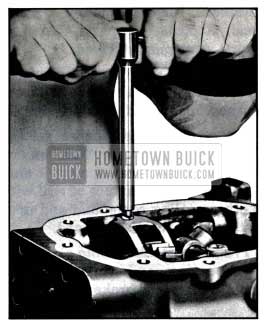
1957 Buick Removing Set Screw with Remover J-2895
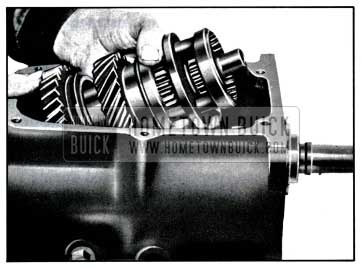
1957 Buick Removing Main Shaft Parts
Cleaning and Inspection of 1957 Buick Synchromesh Transmission Parts
Clean and inspect all ball and roller bearings as described under Bearing Service (par. 1-10). Thoroughly clean all other parts except rubber mountings in CLEAN solvent and wipe dry with CLEAN cloths. Inspect parts as follows:
- Gears and Shafts. Carefully inspect teeth and other ground surfaces of all gears for wear, scoring, pitting, chips, nicks, and burrs. Do not confuse manufacturing cutter marks with scores or pits. Conical surfaces of gears where contacted by synchronizing drums must be smooth and free of burrs. Slight scores or burrs may be honed off with a fine stone, however, if any gear is chipped or excessively worn it should be replaced.
Inspect all shafts for wear roughness on bearing surfaces. Check fit of gears on shafts upon which they are mounted. The sliding sleeve must slide freely on splined section of main shaft, but without appreciable backlash. - Synchronizing Drums. The cam surfaces of synchronizing drums must be smooth. The conical surfaces of synchronizing drums must be free of burrs or scores, and oil grooves must be clean. Never polish this surface or change the angle.
- Selector Shaft, Shifter Yokes and Shafts, Toggle Spring Extension. Check selector shaft and shifter yoke shafts on a flat surface to see whether they are bent. A bent shaft will cause hard shifting, and should be replaced. If a shifter yoke is bent or has rough contact surfaces it will cause hard shifting and noise, therefore, it should be replaced. Replace poppet springs if distorted or of doubtful strength.
Check toggle spring extension to make sure it is not distorted. An improperly shaped extension will bear against the selector shaft and actually tend to pull 1957 Buick Synchromesh transmission out of first speed. Figure 4-21 shows the correct shape for extension. A bent extension should be reshaped to dimension shown, or replaced.
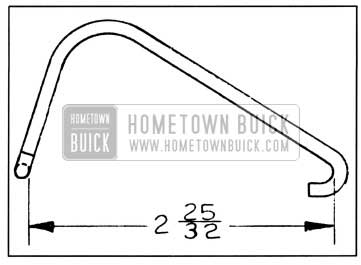
1957 Buick Toggle Spring Extension
Assembly of 1957 Buick Synchromesh Transmission
Assemble the 1957 Buick Synchromesh transmission by reversing the sequence of steps given for disassembly. In addition, observe the following instructions that apply to assembly.
- Condition of Parts. Make certain that all parts are absolutely clean and that gears and synchronizing drums are free of nicks or burrs. Use all new gaskets and oil seals or packings to insure against leakage of lubricants. Use all new snap rings, and retainers of snap ring type. Snap rings, are frequently distorted during removal and are difficult to true up satisfactorily for further service.
- Observe instructions given under Bearing Service (1-9) on proper installation of ball bearings. Coat bearings with clean transmission lubricant at time of installation, to insure initial lubrication.
- Universal Joint. Use Replacer J 855 to install universal joint on main shaft. See figure 4-22.
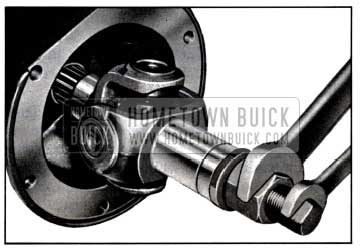
1957 Buick Installing Universal Joint with Replacer
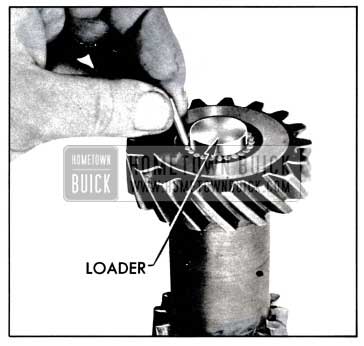
1957 Buick Installing Counter Gear Bearings with Loader
Pack bearing rollers in white vaseline to hold them in place and make certain that all rollers are installed (26 in each bearing). Leave loader in gear until it is pushed out by the counter gear shaft during installation.
When installing counter gear, front end has a bronze thrust washer only. Rear end, however, has a steel washer pinned to case, another steel washer in recessed end of counter gear, and a bronze washer in between. Drive counter gear shaft lock flush with surface of case.
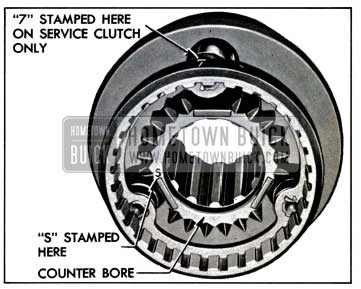
1957 Buick Counterbore and Marks on Second Speed End of Clutch
Make certain that selector shaft slides freely after installation, otherwise hard selection of proper gear will result at control lever.

.super site,answered all my questions